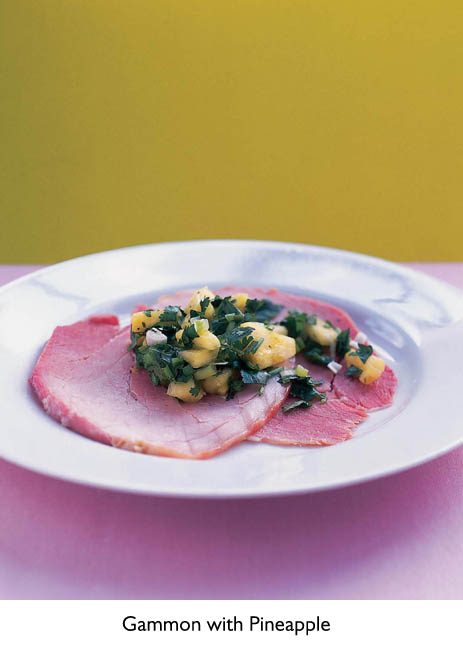Forever Summer (14 page)
Authors: Nigella Lawson

Heat the remaining olive oil in a large frying pan and gently heat the second garlic clove until lightly golden to infuse the oil. Take out the garlic clove and add the prawns to the pan. Cook for 5–6 minutes until cooked through and no longer glassy in the middle. Spoon them over the dressed salad leaves, being scrupulously fair as to how you divide them (if there’s an odd number, I’d wolf it down as you stand by the stove) and sprinkle over the chopped chives.
Serves 2.
SEARED MUSTARD-COATED SALMON
This is an incredibly easy, incredibly quick main course to go with
beetroot salad
and
Hasselback potatoes
. There is nothing intrinsically Scandinavian about it, but the flavours of this soft-fleshed fish dredged in sweet mustard are certainly borrowed from the Swedish palate. The sweet heat evokes the almost honeyed vinegariness of certain herring marinades, or that sauce which goes with gravad-lax, but this way sharpens it, gives it a modern, less cloying edge. The sugar in which the salmon pieces are dredged helps an almost caramelly crust to form, but the acrid heat of the mustard powder undercuts any sweetness.
All I ask is that you don’t dredge the fish until the absolute moment you want to cook it, otherwise the coating will make it claggy rather than crusty.
6 x 200g skinless salmon fillets
1–2 tablespoons olive oil
2 scant tablespoons caster sugar
2 heaped tablespoons English mustard powder
Put a frying pan on the heat with a tablespoonful of oil in it. I’ve specified olive oil, but don’t use the good – extra virgin – stuff here; at this heat, it would be a complete waste.
Mix half the sugar and half the mustard powder on a plate and dunk in half of the fish fillets, first one side and then the other. Cook them on a medium to high heat – you want to hear the pan sizzle – for about 3 minutes a side.
Remove to a warmed plate and do an action replay with the remaining the oil, fish, sugar and mustard powder. The salmon should be a burnished brown without, juicily coral within. Remember, too, that the fish will continue to cook as it waits for a few minutes on the plate before anyone starts to eat it.
Serves 6.
SEA BASS WITH SAFFRON, SHERRY AND PINE NUTS
This is another fabulously easy recipe – and you can be totally relaxed about it. That’s to say, consider it simply a guide: use other fish fillets if you like, or indeed substitute chicken breasts; just remember they’ll need much longer cooking and therefore probably more liquid. I reckon that the kilo of fish stipulated below should be about two medium-sized bass, filleted. I then cut each fillet in half or thirds, so that you’ll have either eight or twelve smaller slices to cook. I love this with a small pile of plain white basmati rice and a contrasting bowlful of dark, muddy lentils.
1kg fillets sea bass, skinned
Maldon salt
2 tablespoons sultanas
good pinch saffron strands
4 tablespoons Amontillado sherry
3 tablespoons pine nuts
125ml water
Cut the fish into smaller pieces, however you want, and sprinkle lightly with salt. Put the sultanas in a bowl, strew with the saffron, warm up the sherry and pour it over. Put a thick-bottomed frying pan on the heat and toss the pine nuts in it until they take on a deep gold colour and give off their waxy aromatic scent. Pour on to a plate and put on one side. Pour the sultanas in their saffroned sherry into the emptied-out pan and add the water, then put it back on the heat and let it come to a simmer, then add the fish fillets, or as many as will fit in one layer; add more water if they are not more or less submerged. After about a minute’s simmering, turn them over with a couple of spatulas. They cook very quickly and if you leave it too long, they’ll flake as you turn them. Give them another minute or so on the second side and remove to a waiting plate. Continue till you’ve used up all the fish, adding more water as necessary. When you’ve finished, use the spatula to remove as many sultanas as you can to the cooked fish on the plate, then turn the heat under the frying pan to high and let the sherry-saffron juices reduce till you have a just-liquid yellow syrup. Pour this over the fish, then scatter over the toasted pine nuts. And that’s all there is to it.
Serves 6–8.


PORCHETTA
This is a domestic take on the Italian marketplace staple of roast suckling pig, and quite my favourite thing to eat in Italy. I’ve specified pork shoulder, but really you can get any cut of pork you want: the important thing is that it’s opened out to form a roughly oblong slab or sheet, which you then smear with onion, fennel seeds, rosemary, bay leaves, ground cloves and garlic, then you roll it up so that the flavourings snake their way through the whole of the joint. Tie it with string, roast it for a good long time then, once it’s out of the oven, leave it till it’s still just warm then slice it thickly and wodge it into buns. Of course you can just carve it and eat it more sedately with knife and fork, but for the echt experience, pretty well unbeatable, you need to taste this aromatic, slow-cooked pork in sandwich form at least once. I tend to keep within the authentic register and get small, individual ciabatta rolls, but even in thick slices of white English bread it’s dreamy. But don’t use a plastic sliced loaf, which will go too pappy, and avoid baguettes: that robust crunch is not what we’re going for here.
2kg neck end pork shoulder, derinded, boned and butterflied
3 tablespoons olive oil
1 large onion, chopped
3 cloves garlic, finely chopped
2 tablespoons fennel seeds
2 large sprigs fresh rosemary, finely chopped
4 fresh bay leaves, finely chopped
1 teaspoon ground cloves
1 teaspoon salt
8 black peppercorns, coarsely crushed
8–10 or so ciabatta buns
Lay the pork out on a chopping board and cover with clingfilm. Using either a rolling pin or meat mallet pound the meat to an even 3cm thickness or as near as you can get. Heat 2 tablespoons of the oil in a frying pan and cook the onion for a few minutes until it’s beginning to soften. Add half the garlic, half the fennel seeds, all the rosemary and bay leaves, half the ground cloves, the salt and pepper, and cook for a minute more, then transfer to a plate and leave it to cool.
Spread this cooled mixture over the pork, rubbing it in well, then roll up the pork tightly and secure at regular intervals with string. If you’re as cack-handed as I am, you might find it helpful to have someone to keep a steady finger on the string as you tie it, but it’s not impossible single-handed.
Mix together the remaining garlic, fennel and ground cloves with the remaining olive oil. Rub this over the surface of the pork. Loosely cover with clingfilm and leave to steep in the fridge overnight or for 24 hours. But do remember to take it out of the fridge a good 40 minutes before you start cooking as the meat has to be at room temperature when it goes into the oven.
So, preheat the oven to 180°C/gas mark 4, and put the pork in a roasting tin and cook for 4 hours. It may need covering towards the end of the cooking time, so look at
it after about 3 – if it looks as if it’s beginning to blacken too much (a little bit of herby burning just adds to the depth of flavour), tent it loosely with foil for the last hour.
Remove from the oven and leave, uncovered, for an hour or so before slicing it, stuffing it into whatever rolls or bread you’re using, then just sink your teeth into these melting-bellied, dangerously compulsive bulging buns.
Fills 8–10 buns.

GAMMON WITH PINEAPPLE
For all that we try and put the blame on the Hawaiians, there does seem to me to be something ineffably, if embarrassingly, English about the combination of ham and pineapple. I do not want to eat them together on my pizza, but like this, they justify the pairing. You may smirk, but this is not intended as an ironic exercise in gastro-rehabilitation here. Food, like life, has to be real, and this tastes really good. For all my robust internationalism – motto: if it tastes good, eat it – I do think that in the few warm weeks given to us, one wants food that reminds one of past summers, long ago ones, real or wistfully imagined. For me this means cold ham. Not that this is by any means an exclusively summer notion: when it’s cold out, eat the gammon – as ham should properly be called once it’s cooked – hot, but keep this accompaniment of sunny pineapple relish or salsa, however you want to think of it. You can use either mint or coriander in the pineapple relish: coriander takes it definitively into the domain of the salsa; mint gives it a cooling, English air. You choose. And if you want to mix the relish in the processor, then roughly chop everything, put the herbs and onions in and blitz first, then add the pineapple and lime juice and pulse.
These days, I find that you don’t need to soak ham before cooking it, but if you have any reason to believe you’ve got a piece of extremely salty ham in front of you, either sit it in a sinkful of cold water overnight or, when you cook it, put it in a panful of cold water, bring it to the boil then chuck out the water and proceed as below.
1 x 2.5–3kg mild cure gammon joint
1 x 1 litre carton pineapple juice
1 ripe pineapple
5 spring onions, trimmed, halved then finely sliced
juice of 1 lime
4 tablespoons chopped fresh coriander or 6 tablespoons chopped fresh mint
1 green chilli, deseeded roughly and finely chopped
salt
To cook the gammon, put the joint in a pan, pour over the pineapple juice and then add cold water to cover well. Put the pan on to boil, then turn down and cook at a simmer for 50 minutes per kg then, once it’s cooked, let it sit and cool in the liquid. Or eat it straightaway, keeping the liquid so that any leftovers can cool in it afterwards; this is the best way of making sure the gammon doesn’t dry out as it cools.
To make the relish, slice the pineapple, halve the slices then cut away the core and the skin and chop the fruit finely. Squeeze the pieces of skin over the bowl to catch any juices going, then stir in the onions, lime juice, herbs and chilli and add salt to taste, remembering that the ham will be fairly salty.
Serves 8.

